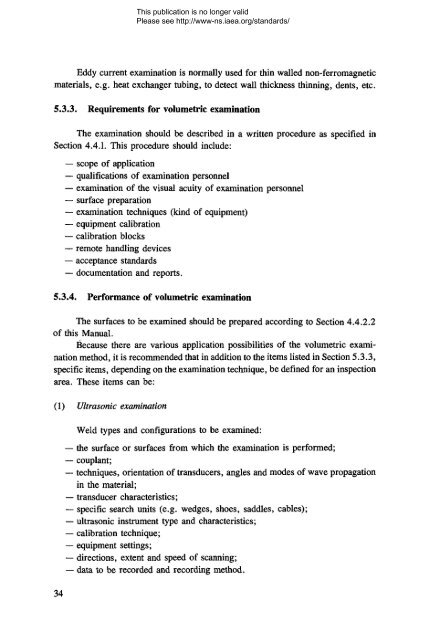In-Service Inspection of Nuclear Power Plants - gnssn - International ...
In-Service Inspection of Nuclear Power Plants - gnssn - International ...
In-Service Inspection of Nuclear Power Plants - gnssn - International ...
You also want an ePaper? Increase the reach of your titles
YUMPU automatically turns print PDFs into web optimized ePapers that Google loves.
This publication is no longer valid<br />
Please see http://www-ns.iaea.org/standards/<br />
Eddy current examination is normally used for thin walled non-ferromagnetic<br />
materials, e.g. heat exchanger tubing, to detect wall thickness thinning, dents, etc.<br />
5.3.3. Requirements for volumetric examination<br />
The examination should be described in a written procedure as specified in<br />
Section 4.4.1. This procedure should include:<br />
— scope <strong>of</strong> application<br />
— qualifications <strong>of</strong> examination personnel<br />
— examination <strong>of</strong> the visual acuity <strong>of</strong> examination personnel<br />
— surface preparation<br />
— examination techniques (kind <strong>of</strong> equipment)<br />
— equipment calibration<br />
— calibration blocks<br />
— remote handling devices<br />
— acceptance standards<br />
— documentation and reports.<br />
5.3.4. Performance <strong>of</strong> volumetric examination<br />
The surfaces to be examined should be prepared according to Section 4.4.2.2<br />
<strong>of</strong> this Manual.<br />
Because there are various application possibilities <strong>of</strong> the volumetric examination<br />
method, it is recommended that in addition to the items listed in Section 5.3.3,<br />
specific items, depending on the examination technique, be defined for an inspection<br />
area. These items can be:<br />
(1) Ultrasonic examination<br />
34<br />
Weld types and configurations to be examined:<br />
— the surface or surfaces from which the examination is performed;<br />
— couplant;<br />
— techniques, orientation <strong>of</strong> transducers, angles and modes <strong>of</strong> wave propagation<br />
in the material;<br />
— transducer characteristics;<br />
— specific search units (e.g. wedges, shoes, saddles, cables);<br />
— ultrasonic instrument type and characteristics;<br />
— calibration technique;<br />
— equipment settings;<br />
— directions, extent and speed <strong>of</strong> scanning;<br />
— data to be recorded and recording method.

















